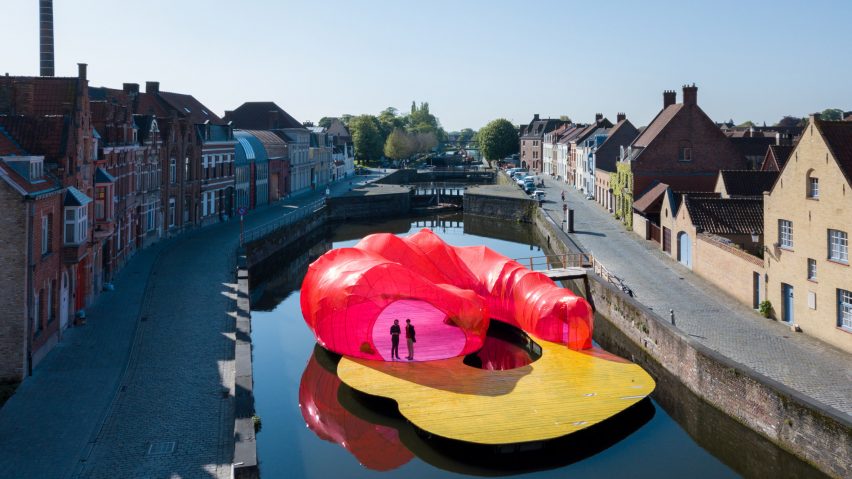Spanish architecture duo José Selgas and Lucía Cano has erected a pink vinyl pavilion on a canal in Bruges, which floats between the city's historic brick buildings.
The pavilion was created for Trienniale Bruges, an event that invites a global selection of artists and architects to produce unique temporary structures. Displayed at different points throughout the city centre, it's hoped the constructions will "form a hospitable route that brings people together in unexpected spots".
Having launched in 2015, the second edition of the triennial focused on the theme of Liquid City, which makes reference to Bruges' renowned network of waterways.
SelgasCano – which is led by architects José Selgas and Lucía Cano – decided to build their pavilion on the Coupure canal, hoping for it to serve as a new sunbathing platform for swimmers.
It features a bulbous shell crafted from fluorescent-pink vinyl, sat atop a yellow timber base. Underpinned by steel rods, the structure was hand-assembled in situ so that materials could be welded or stretched where necessary to fit the site.
Its chrysalis-like shape echoes the pavilion that Selgas and Cano designed for the Serpentine Gallery two years ago, which was created from sheets of colourful flourine-based plastic.
"Steel structure and plastic skin are just one thing, indissociable from one another," said the studio in a statement.
"Light passes through the skin, creating a shambling atmosphere that changes the usual perception of the old city."
The structure is bookended by two irregularly-shaped openings and curves around a void at the platform's centre to form a tunnel through which visitors can wander.
For the inaugural Triennial Bruges in 2015, Tokyo-based practice Atelier Bow-Wow created a large wooden sun deck that offered the city's canal swimmers a place to stop and relax.
SelgasCano has previously created an undulating pavilion for France's Foundation d'entreprise Martell, which comprised of 31 rows of translucent fibreglass waves. Most recently the pair turned their hand to architect Richard Rogers' former studio, transforming it into a plant-filled workspace for Second Home.
Photography is by Iwan Baan.

